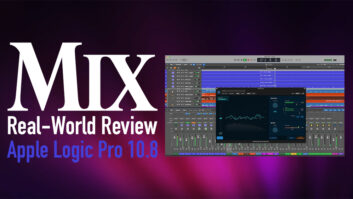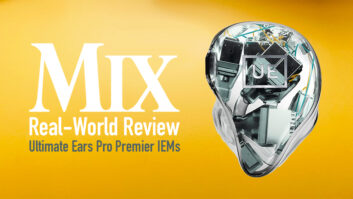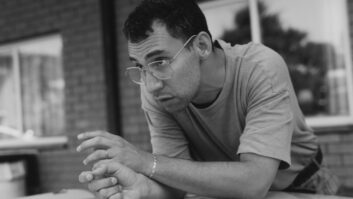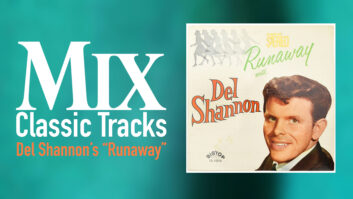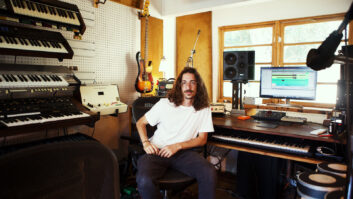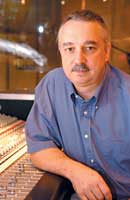

As the signature sound of world music groups to Latin acts like Gloria Estefan and contemporary pop legend Carlos Santana, percussion plays an essential, even lead role in the mix; in some cases, even to the point of “sharing” vocal duties with lead singers. To balance the nuance of percussion’s contribution, engineers have developed some very specific techniques. Mix talks to some of the industry’s foremost drum-savvy engineers—Eric Schilling, Jim Gaines, Antonio “Moogie” Canazio and Tom Flye—to find how they capture the essence of these unique instrumental personalities.
Photo: Maureen Droney
ERIC SCHILLING: MIAMI HEAT
Originally from the San Francisco Bay Area, Eric Schilling has been a leading light in the Miami recording scene for the past two decades, working extensively with Gloria Estefan (more than a dozen albums) and top Latin artists such as Cachao, Raúl DiBlasio, Ricky Martin, Julio Iglesias, Shakira, Thalía and Cuban horn legend Arturo Sandoval.
Schilling stresses that each style of what is commonly called Latin music has its own peculiarities and demands. “When I started recording Latin music, I had to adjust to what the norms were, and once I got used to the way things are normally done, it really made sense to me and you realize that songs might not work unless you do it that way,” he says. “In salsa music, for example, the cowbell is always very prominent; in fact, it’s sometimes almost as loud as the lead vocal. In some ways, the music is based around that beat, and if you don’t mix it that way, it sounds weird to people. Last fall, I did a merengue artist and that’s also quite stylized, right down to where you pan things because that music is based on a couple of things including the guiro, which is like a gourd that has a fine ridge down it and you play it with a stick or a wire brush and it’s very bright; it’s almost like a hi-hat.
“If I have a project where I have a lot of percussion, say four or five things at the same time—guiro, cowbell, conga, timbale—I don’t go for a lot of room sound; even with close-miking, you’re still going to get a lot of bleed from a percussion section. For congas, if there are two drums, I’ll typically do it with one microphone off the drum a bit—say a foot-and-a-half in front of the drum and a foot or foot-and-a-half above it, depending on how well the drums speak. I sometimes use the Sony 800G mic because it’s a little bit bright if you get away from the drum a bit. If the drums are really dark, I’ll probably get a little closer to get more slap of the hands. If the player’s really good and the guy has a great sound to start with, I don’t need to be quite as close.
“For timbales, I do what most people do: mike them from down below and from up-top. You do it from below because on a lot of Latin stuff, especially if it’s salsa, they use the cascada sound, which is when they play the side of the drum. So you need the mic below to get it. Typically, I’ll take a pair of [Sennheiser] 421s or maybe some kind of dynamic below and then I’ll put condenser up-top—of course, you have to flip the phase of them—and what you have to do is get a balance between the different sounds: the crash, the cowbell, the fills, the cascada.”
When it comes to preamps with percussion, “It totally depends on the console,” Schilling says. “I’m not one of those people who thinks you have to have a specific preamp for a particular instrument. If I’m on a [Neve] VR, I’m pretty content to use the preamps in the console. If I’m on one that’s not quite up to that snuff, I have a couple of outboard preamps—Neves that I go to first for percussion. I also have some Crane Song stuff I really, really like, but I don’t tend to use that for percussion.”
Schilling has been recording to digital since the late ’80s, working on such fondly remembered machines as the AMS AudioFile, Akai PostPro and Mitsubishi 32-track before the current wave of workstations. Digital definitely affects how he cuts percussion: “What you hear is what you’re going to get, with nothing added,” he notes. “There’s no fatness added [like there is with analog tape], so you have to be careful not to make it too bright because there’s no softening of the top end, which [analog] tape is going to do.
“With a percussionist, it’s all about the tone he gets. Gloria’s had the same guy for years and he has a unique sound and takes a lot of care with his drums—his drums are like his kids to him. So you start with the person playing and then it’s the drums they’re playing. If those two things are good, my job is pretty straightforward. If a percussionist has a bad set of drums—if they’re very dark and I have to add a lot of top end—it’s more of a struggle. To make it brighter, I might pick a 414; if they have really nice-sounding drums, I’ve used Sony C-37. If they’re really struggling, I might use a 421 if the midrange isn’t there.”
And if he only had one mic for a table of hand percussion? “I’d use a 414. It might not be the absolute best mic for all things, but it’ll work on a lot of things and it’s very reliable.”
JIM GAINES: THAT SANTANA SOUND
Memphis-based Jim Gaines’ resume includes discs by everyone from Albert Collins and John Lee Hooker to the Neville Brothers and Stevie Ray Vaughan. But we wanted to talk percussion with Gaines because he’s worked on and off with Santana for more than two decades, including such important works by the band as Shango, Blues for Salvador, the google-Platinum Supernatural and last year’s hit follow-up, Shaman. When we spoke in early May, Gaines and Santana were toiling at a West Coast studio in the beginning stages of the group’s next album.

Have there been any changes in the way he records Santana’s vaunted percussionists during the years? “Nothing in terms of how I approach them,” he says, “but we have some newer microphones to work with. When I first started with Carlos in the early ’80s, a lot of the mics being used were 87s—older mics—and some of the new breed—[AKG] 414s. Now, I’m sort of between those two worlds. For a while, I used some of the Shures—90s and 91s; little condenser mics you can clip right on [percussion]. The group was using them live, and we tried them in the studio and they were okay, but now I’ve gone back to using [Shure] 57s on both the congas and timbales. I’ll also sometimes use RØDE mics—1000s—in some of the mixes, and sometimes 414s if I want brightness out of the timbales.
“The great thing about using 57s on congas is they can take the power and still get the clarity you want. Congas are not simple instruments to record—there’s a lot to the sound: the slap of the hand, the drum’s resonance, how the different drums combine. A really good player will give the snap to make that conga ring over. The conga has a lot of tone with the right guy playing it; with the wrong guy playing it, it’s just a thud. Raul [Rekow, Santana’s long-time conga player] plays five congas, each tuned to a different note. Generally when I’m recording, I’ll want one mic for each drum—usually 57s—just a few inches off the head. With five drums, we want the separation. And if I can get by with it, I also try to do a little room miking to add a little air to him. And that [mic] can be anything—an 87 or I may use the RØDEs. If we’re cutting drums in the same room, obviously I can’t open up [the room mics] too much, so I’ll mike [the congas] tighter. In an overdub situation, though, I’ll get off them a little bit more.
“For Karl Perazzo’s timbales, we’ve tried a couple of different things. Sometimes we mike them underneath with 57s and sometimes we go over the timbales. The problem with miking over the timbales is you get so much cowbell in there. That’s where the cowbells sit and you have to be careful not to let that overpower everything. So we’ve gone back and forth—over and under. I’ve also used 421s there. With timbales, you want to get the attack of the stick hitting the head and rim at the same time.
“Karl also plays congas—he has two on his set—and we sometimes mike those as one and sometimes as two, depending on whether we’re trying to cut back on the mics. There’s a djembe, which I mike under, to get the bottom end. And then there’s a surdo, which is this great [Brazilian] low-end drum that Raul plays with a big mallet. On that one, I like to use an [AKG] D-112. I treat it like a bass drum. Karl also has what we call the toy section, which is little bells and a chime tree and things like that. You’d be surprised at how loud some of those little instruments can get; you have to be careful with them. We’ve used different combinations of 57s and 421s and, again, a 414 as an overhead to give us some air.”
And a final note on recording percussion with Santana: “For the past few years, Carlos has been working with a lot of songwriter/producers, so we’ll get stuff cut in home studios that already has drum machines or other [synthesized] percussion parts. Fortunately, most of them leave us space because they know we have a percussion section. What happens a lot of times is the writer will put down a guide percussion track and then we’ll replace it with Raul and Karl. But occasionally, we’ll leave some of the writer’s own little percussion touches because it adds to the track; we just have to be careful not to get the sound too saturated. What’s funny is now a lot of people are sampling [Karl and Raul], so our guys end up playing with their own sound already. We’ve run into that several times.”
“MOOGIE CANAZIO: FROM RIO (AND L.A.) WITH LOVE
In Brazilian popular music, percussion is paramount—everything from huge sections of large-frame drums to the insistent rhythmic ting of tiny triangles. Growing up in Rio de Janeiro, Antonio “Moogie” Canazio was an aspiring drummer in a city filled with them. But he first made his name in the music business as a club DJ in the early and mid-’70s, and later as an engineer in Los Angeles’ Kendun Recorders and other studios. Since those days, he’s gone back and forth between Brazil and L.A., working with top acts in both countries. Among the Brazilian giants he’s worked with are Sergio Mendes, Caetano Veloso and Maria Bethania.

By phone from Brazil where he was mixing a live DVD for Bethania, Canazio began talking about how he recorded the electrifying opening of Mendes’ ground-breaking Brasileiro album, which featured more than 100 top drummers from various Brazilian samba schools. “Believe it or not, that was done in a parking lot,” he says. “Obviously, what we were trying to get was some of the magic of the Carnivale. You have this big parade with all these different schools of drummers competing—you can have 3,000 or 4,000 drummers there. I ended up recording about 140, and I miked them as if I were miking a symphonic orchestra: I had sections with some mics far away for ambience, because part of the sound of those groups is that it’s like this faraway call that says, ‘Wake up! We’ve got to go!’ and then some mics up closer. In all, I had about 40 mics going on, all hanging on trees, because I recorded it in a parking lot. On that, I was using pairs of [Neumann] M50s for the ambience. Five minutes before the down beat, we had a thunderstorm, so I had to run down and tear down the microphones. Half-an-hour later, the sun came out and we put them up again. That turned out to be the only usable take. It was magical.”
When asked about recording something as simple as a triangle, so prominent on many samba records, he says, “Believe it or not, the triangle is one of the hardest instruments to record,” he says. “Actually, it’s what I sometimes use to test a microphone or a preamp, because triangles have a really, really fast transient and are extremely rich in harmonics, and it’s very easy to crap up and make them sound bad. So you need good microphones with good capsules. I’ll probably use an AKG 452—it’s a bright, but not brittle, microphone. With triangles and hi-hats, you have to go a little lower on the tape and bleed is always going to be an issue.
“On the other end, in Brazilian music you sometimes have a surdo [drum] that is very hard to record—you have a lot of level, but you can barely hear it because it has dark energy and so much low end. I’ll mike it from the top to get the first reflection, and depending on how it’s tuned, I might use a Sennheiser 421 right at the center aiming at where the batter is going to hit. And then at the border, I use a U47 FET, which can take quite a bit of level without crapping out, and I mix them so I have the impact of the low end.”
When faced with a percussion section of four or five players, Canazio says, “I’ll always mike an ensemble with a stereo pair for the room, as well as each individual. I don’t put the room mics too far away, maybe eight or 10 feet from the source at eye level—actually, ear level. I might use a pair of [AKG] C12s or C12As, or [Neumann] M50s or M49s, and I can track that separately to try to get the sound of being in the room listening to them.
“When I record a single percussion player, I will change [the equipment] totally with each part. I might use a 452 with a Neve 1084 the first time, and if I have to double, I will use a totally different microphone and a totally different preamp [for the next pass]. The more apart they are, sonically speaking, the better.”
Canazio says that his preamps have been the best investments in his rig. “I have a pair of Neve 1073s, I have a pair of 1084s and I also have a pair of the new 1084s that Brent Averill [Enterprises] put together, and those are outstanding. I have APIs—most of Sergio’s [Brasileiro] album was through APIs—and I also have Calrecs [from an old Calrec board]. Even though there are a lot of outstanding new preamps out there, when you’re dealing with Pro Tools, you need to recover the warmth, and for that, the older preamps are unbeatable.”
TOM FLYE’S WORLD OF PERCUSSION
Veteran San Francisco Bay Area engineer Tom Flye has worked with dozens of amazing artists since breaking into music in the late ’60s (as drummer for Lothar & The Hand People!), including Sly & The Family Stone, Rick James, Don McLean, Curtis Mayfield, Frank Zappa and many others. But his longest and most creative relationship has been working with Grateful Dead percussionist Mickey Hart on his many solo albums, all of which have featured unusual blends of percussion from around the world. A “typical” Hart session for his occasional band, Planet Drum, might include Indian tabla player Zakir Hussain, Puerto Rican conga phenom Giovanni Hidalgo, Nigerian talking drum specialist Sikuru Adejopu, Brazilian percussionist Airto and anyone else from around the globe who happens by. It’s probably fair to say that no other engineer has recorded as many different percussion instruments as Flye.
Asked how his approach to recording percussion has been affected by the wide range of Hart’s projects, Flye notes, “I’ve found that I’m using a lot more dynamic microphones than condenser microphones these days. Sometimes with percussion, if you use a condenser mic, you end up getting too much attack and the attack is too bright, especially if you’re doing multiple percussion. It can end up being kind of thin-sounding, like orchestra percussion. But with a lot of percussion—especially any that has a ‘throat,’ a voice; the talking drum is a classic example, but any drum that has a variable tonal quality to its sound—I find that dynamic mics give me more of what I want to hear.”

Photo: David Gans
So which mics does he favor these days? “It’s amazing how often a Sennheiser 421 works or [Sennheiser] 409s, anything in that category. For things that have a big bottom, like a taiko drum, I’ll go with a Beyer M-88. But you can also get away with a condenser mic in those situations because there is so much bottom.
“For tablas, I’ll use one or two 421s. There, you get fairly close to the drum—you just have to leave enough room for their hands. You need to be close so that you can get the sound of the drum and of the fingers—there are all sorts of different finger techniques they use that can be very subtle. And the drums themselves can be tricky because one has more high and mid so it appears to be louder, and the other more lows. So you have to get the balance between those and that can be hard with one mic.”
“Berimbau [a one-stringed Brazilian gourd instrument] is hard to record because the tone is what you’re after and that comes out of the gourd, which is usually right by the player’s belly. So the trick there is to get close enough to get the subtlety of it without actually hitting the player.”
“With a shekere [a gourd covered with percussive beads], usually what you think of is just the shake sound, but a good player will also hit the bottom of the gourd periodically in his pattern, and to make it so you can hear that can be challenging. So what I’ll do there is stick the mic as close to the hole as possible and get him to play the hole of the gourd into the microphone. You still get all the shake you need, but you also get that nice, low-end thump.”
And talking drum? “A 421 close to the head so you pick up the attack, but if I have the tracks, I’ll also add a second mic at the back and throw that one out of phase.”
When it comes to augmenting the percussion with other gear, Flye remains a traditionalist: “Give me a Neve console or an API, and I’ll be happy. I like what [Neve] 80 Series preamps do to percussion. Especially if I’m [recording] in the digital domain, those will help give the sound a little more depth. Digital can be pretty transparent.” Generally speaking, even if he’s recording a number of players together at the same time, he’ll favor close-miking over getting a big room sound, “because we might want to have more flexibility later to change the arrangement, add or subtract things. It’s obviously harder to do that when there’s a lot of bleed.” So Flye will add processing later to create the “room” he wants. “I still like the old Quantec QRS and any good-sounding plate. The new TC 6000 also has some really good-sounding programs.”
